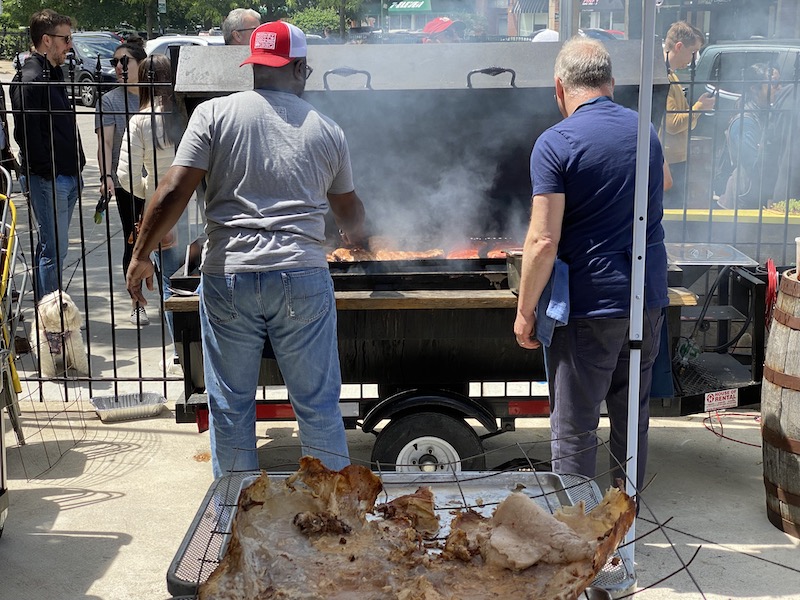1. THE CHICAGO WAY
Years ago, I worked with a woman whose father was a retired Teamster. He worked on the Untouchables TV show (the newer one that followed the Kevin Costner movie), and they liked his real-Chicago-guy look so much they cast him in a couple of episodes as a boxing manager. Anyway, I suggested at one point that he should pass along the idea of using Orange Garden on Irving as a location—the Chinese restaurant, like her dad, had a perfect gangster-era Chicago look; all they’d have to do was take down the No Smoking signs (from the restaurant, not her dad).
Little did I know how right I was, says Louisa Chu:
Orange Garden had another gangster connection.
“Many people came to George Chen’s restaurants,” wrote Tribune columnist Anne Keegan in a profile. “One of his best customers was a good looking man who was always polite. … It was not until he was killed and his pictures were all over the newspapers that George Chen realized his best customer had been John Dillinger.”
There’s lots of flavorful stuff like that in Louisa’s profile of the restaurant, as its sign goes away and its future is a bit uncertain.
2. HOLUDECK
For years one of my complaints has been that reviewers here tend to regard Chinatown as an undifferentiated mass of restaurants—when’s the last time someone named a Chinatown opening one of the best of the year? So I’d be excited for Chicago mag reviewing the upscale steak place Holu—if not for the fact that they attribute it to some neighborhood called East Pilsen. East Pilsen? It’s in 88 Marketplace in Chinatown, dammit! (Or did we decide China-town is racist? I might have missed that while having Tiki drinks somewhere.)
Holu, which means “fire pit” in Chinese, is the first restaurant from owner Jason Song, who grew up in Shenyang, China, and came to Illinois as a finance student. He owes an obvious debt to Cote, the New York restaurant that pioneered this smart combination of dry-aged meat, fine drink, and downdraft grills. But while Cote hews closely to the conventions of Korean barbecue in packaging the meal, Holu takes a more pan-Asian approach in choosing side dishes and sauces. While these accompaniments taste like throwaways and Song badly needs an editor to help him execute his vision, he’s onto something great — the main meaty bites are a thrill.
3. PERU STREET
Speaking of beef, I’m pretty enticed by Titus Ruscitti’s description of a signature dish at Avenida Peru in Cragin:
Though you’ll find lomo saltado — beef tenderloin with fries, tomatoes, onions, and a smoky soy sauce — all over town, I’ve never had one as good as this, thanks to those crisp-tender fries and a deft hand with the wok.
4. OLD BAY
If you have the Fat Rice cookbook or Let’s Make Ramen!, you know chef and cookbook author Hugh Amano. (I interviewed him and illustrator Sarah Becan about the ramen book here.) His latest project has been a rather poshly-produced periodical about cooking called Bon Vivant, but I didn’t know the story behind it—and neither did Mike Sula, he says in a piece on it:
Turns out, the only way Amano could’ve written any of those books was because of the nine-to-five gig he took on in 2013 making lunch for a couple dozen employees of a low-profile commercial real estate firm.
Sula is being ironic, it’s mega-developer Sterling Bay, who turn out to be among the good guys in this story, underwriting his endeavors when he became their in-house chef and especially when he reacted to lockdown by sending out useful recipes for staffers working from home.
Last October Sterling Bay published the first issue of Bon Vivant: A Culinary Journal, focused on Amano’s obsession with wood-fire cooking. At 102 pages, lavishly documented by house photographer Kevin Hartmann and laid out by graphic designer Alexis Teichman, it’s a technique-heavy collection of recipes that features a piece on John Manion’s El Che Bar, as well as travel stories about hunting and cooking along the Provo River in Utah (johnnycakes, ember-braised pork guiso), and a visit with an old culinary school pal in Montana (elk and venison sausages, willow-skewered trout). There’s also a piece on cooking paella on the banks of the Chicago River along a flattened stretch of Sterling Bay’s Lincoln Yards development.
A new issue is coming out soon; find out more here.
5. CDMX-CELLENT
One of my goals is to get back to Mexico City, though I don’t know when (I have two flights planned this year in directions far away). But when I do, you can bet one of the first things I’ll consult will be this epic report from Titus Ruscitti:
It had been more than five years since we last visited. Hopefully that’s the longest stretch in between visits bc Mexico City is one of my favorite places in the world. Of course it starts with the food which is a melting pot of regional Mexican food. The street food in Mexico City is commonly mentioned as some of the best anywhere and it is but as I would learn on this trip the fine dining is equally awesome. Me and the wife were joined by my aunt and uncle so I made sure to have a handful of reservations in place so we weren’t running around trying to find a spot where we could get seated. Mexico City’s size means there’s never an off night. Reservations are highly recommended at any spot you really want to check out that takes them. Last trip in I ate a ton of tacos and other street food favorites but we didn’t get a single reservation so you don’t need them unless you plan on checking out the city’s nighttime dining scene which you most definitely should.
6. THE FOOD GAIJIN
The last stop on Steve Dolinsky’s tour of Asian-American and Pacific Islander cuisines is Japan, as he looks at some less-common-than-sushi specialties: okonomiyaki and the dessert kakigori at Paul Virant’s Gaijin, and matcha desserts at Kyo Matcha in Chinatown.
7. UR-BURGER
Was the hamburger invented in a small town in Wisconsin? There’s plenty of places that claim that title, and many of them may have a good case, so here’s Seymour, Wisconsin’s:
Less than a half-hour west of Lambeau Field, where the Green Bay Packers play, Charlie Nagreen’s name is equally well known as those of legends like Vince Lombardi, Bart Starr and Brett Favre.
In downtown Seymour, a 14-foot statue of Nagreen towers above Depot Street. But that’s not a football he’s holding in his left hand — it’s a hamburger. By most accounts, Nagreen made his mark on history as the first person to sell a simple sandwich of a ground beef patty, onions and pickle between two slices of bread.
Yeah, but tell it to Louis Lunch in New Haven or the Menches Brothers of Canton, Ohio—not to mention Ralph Baum in Wichita.
8. STURGEON’S STURGEON
“At least half of all ‘good’ restaurants, even those lauded by critics, are at best, slightly above average. I’d say 80% of all restaurants are average or worse,” begins Michael Nagrant in his latest essay at his Substack, The Hunger. I have to disagree; whenever I travel other parts of the midwest, 80% of the time I’m struck by how reliably good Chicago cooking is, and 20% of the time I’m impressed by how you can find cooking at a Chicago level in smaller places throughout the region. But anyone, it’s all his preamble to a new series called Essential Essentials (hmm, sounds oddly familiar; also “essential” seems to be the word Eater Chicago is using for most of its listicles these days), for which you’ll have to subscribe to find out who made it.
9. JAVA FIVE
Coffee is coffee. except when it’s culture, as the owner of Viet Five, a Vietnamese-owned coffee importer and cafe in the West Loop, tells Rebecca Holland at NewCity:
“I wanted to share our story, our journey,” [Tuan] Huynh says. “As Vietnamese refugees, we’re almost a transient culture. People are confused about who we are, so through storytelling and brands and products, people get clarity on what Vietnamese culture actually is.”
10. MR. WOODCOCK
Hammond talked about spotted dick, and now Sandwich Tribunal talks about Scotch woodcock:
Often described these days as toast with anchovies and scrambled eggs–though anchovies and scrambled eggs describes an entirely different savoury dish–the original recipe from Mrs. Beeton’s Book of Household Management features something more like a cream sauce, thickened with egg yolks, poured over toast and mashed anchovies.
More interesting than the dish itself is why it exists at all. Read more here.
11. LULU’S BACK IN TOWN
I mentioned the surgery and fundraiser for Lulu Alvarez, owner of Mexican restaurant Pueblo Nuevo, a few weeks ago. Block Club has more on her return to her restaurant.
12. SERVIS NON COMPRIS
John Kessler sent me this a couple of weeks back and I kept forgetting about it—which is not a comment on it! It’s a piece for Southern Foodways’ Gravy magazine about what service means in the post-lockdown era:
Staffers who continued working through the lockdowns and the shifting directives and rules regarding contact felt “more empowered to make their boundaries clear,” says [former Grace staffer Bree] Schaffer, now general manager at a private club and coworking space. They are more demanding about what shifts and stations they’ll work, and what degree of contact they are willing to make with guests.
Those who did return to floor service after the spring 2020 quarantine found a changed world. “When we first opened, it seemed like we were going into battle,” recalls Atlanta restaurant manager John McDaniels. At the time he was working at Two Urban Licks, a cavernous place with a young, heavy-drinking crowd. “They didn’t care about the mask thing, they didn’t care about the social distancing thing,” he says. “It was always a battle between you and the guest.”
13. KLAATU SOTANO NIXTA
One of the things that’s good to see is that chefs are getting around and visiting restaurants in other cities. Big BBQ star Rodney Scott, who won the James Beard Award for Best Chef Southeast in 2018 here in Chicago, was just here dishing up plates of whole hog at Big Star. Kwame Onwuachi, who’ll be hosting the Beards on June 13, did an event at Virtue on Friday. Here’s one that’s coming up, so if you missed the others, you don’t have to miss it: on June 14, during the Beards weekend, Bar Sotano will welcome Edgar Rico of Austin’s Nixta Taqueria, an Emerging Chef nominee, for a dinner, very reasonably priced at $60, described as follows:
Like the Nixta crew, we have a deep love for modern tacos and masa snacks made from beautiful heirloom corn, and that’s what you’ll find at our collab. $60 gets you all the food: aguachile, four certified “bomb-ass” tacos —two from Nixta, one from Bar Sótano and a one-time-only collaboration taco—plus dessert.



